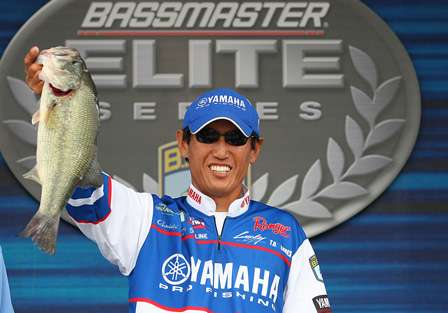
Chad Griffin, an Alaska native who now lives in Cresson, Texas, caught the biggest bass of the tournament by carefully studying Oneida's past and meticulously fishing selected spots.
"I knew several of the guys, including Mike Iaconelli, had caught really heavy sacks flipping the grass last year so I thought that would be the way for me to start. I found several productive clumps across the river on the flats not too far from the launch site.
"One little spot in particular produced a 7-pounder during practice. (I was setting the hook every five bites or so. I wanted to know what was there but I didn't want to over fish anything.) That's a giant fish on Oneida. I knew I was on to something after that."
The spot he found was a small clump of grass — three kinds all mixed together — growing under 9-11 feet of water with a big rockpile sitting right in the middle of it.
"I think that's what made it better than the others. It was different. Most of the clumps I found had a fish or two on them, but this one was definitely home to the giants. I caught the biggest one of the event on my third flip the first morning of competition. How's that for a first fish on the first day?
"That big one wasn't an accident, either. In addition to the 7-pounder in practice and the 5-pounder on Thursday, I caught a 4-pounder off it on Friday. All those fish came from one little patch of grass … amazing.
"The lesson here is to study the history of your water and never overfish a spot in practice. Practice is for finding locations, eliminating lures and developing patterns. It's not for catching bass. I know it's hard not to catch them when you know they're there. Catching fish is a lot of fun, but it's more fun to catch fish and cash a check."
Griffin flipped and pitched the grass with his own 1 1/2-ounce Ezee Grass Jig, brayos craw, on a 7-foot, 11-inch Custom Angle Rod — extra, extra-heavy action — and a Shimano Chronarch Mg reel (6.2:1 gear ratio) spooled with 20-pound-test Seaguar InvizX fluorocarbon line.
"I had no intention of losing a bass once I had it hooked."
